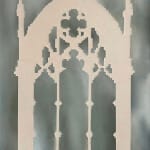Kristijonas Gurčinas Lithuanian, b. 2001
64 bitų šventykla / 64 bit sanctuary, 2025
Aliejus, akrilas, drobė / Oil and acrylic on canvas
60 x 40 cm
Kristijonas Gurčinas's work emerges from analysing both personal and universal relationships with images that symbolise death, spirituality, and the beyond. Gurčinas is interested in how visual representations of death, spirituality,...
Kristijonas Gurčinas's work emerges from analysing both personal and universal relationships with images that symbolise death, spirituality, and the beyond. Gurčinas is interested in how visual representations of death, spirituality, and the sacred circulate in contemporary visual culture.
Today, images of the beyond are commonly encountered in popular culture, in the iconography of certain cultures, and more broadly in secular aesthetics. This prompts reflection on how such imagery is increasingly commodified and demystified, thereby losing its original meaning and purpose. Skulls, bats, blood, crosses, religious icons, and many other symbols of death and spirituality can now be found on T-shirt prints, jewellery, tattoos, films, and video games. Such commercial applications may suggest that their function has shifted. Symbols that once stood for philosophical, spiritual, and existential contemplation have become objects of fashion, entertainment, and pop culture. In the artist's view, this transformation of the imagery of the beyond into a product reflects the cultural background of contemporary society, in which people increasingly seek to avoid confronting existential questions.
Gurčinas explores these themes through painting as a form of visual research. He collects and systematises images from various sources: internet archives, books, films, museum collections, family funeral albums, and video games. These motifs live in his personal visual archive, where they are constantly reviewed, edited, and deconstructed. The artist searches for tensions - points of intersection between an image’s original meaning and its reinterpretation, between the sacred and its imitation, between authenticity and surface. He creates images that are transformed fragments - places where the old and the new, the sacred and the everyday, collide. Gurčinas is interested in how, through the continuity of the image, one can speak about the state of contemporary spirituality - often ironic, unbelieving, yet still searching for symbols that might fill the sense of transcendental emptiness.
Today, images of the beyond are commonly encountered in popular culture, in the iconography of certain cultures, and more broadly in secular aesthetics. This prompts reflection on how such imagery is increasingly commodified and demystified, thereby losing its original meaning and purpose. Skulls, bats, blood, crosses, religious icons, and many other symbols of death and spirituality can now be found on T-shirt prints, jewellery, tattoos, films, and video games. Such commercial applications may suggest that their function has shifted. Symbols that once stood for philosophical, spiritual, and existential contemplation have become objects of fashion, entertainment, and pop culture. In the artist's view, this transformation of the imagery of the beyond into a product reflects the cultural background of contemporary society, in which people increasingly seek to avoid confronting existential questions.
Gurčinas explores these themes through painting as a form of visual research. He collects and systematises images from various sources: internet archives, books, films, museum collections, family funeral albums, and video games. These motifs live in his personal visual archive, where they are constantly reviewed, edited, and deconstructed. The artist searches for tensions - points of intersection between an image’s original meaning and its reinterpretation, between the sacred and its imitation, between authenticity and surface. He creates images that are transformed fragments - places where the old and the new, the sacred and the everyday, collide. Gurčinas is interested in how, through the continuity of the image, one can speak about the state of contemporary spirituality - often ironic, unbelieving, yet still searching for symbols that might fill the sense of transcendental emptiness.








